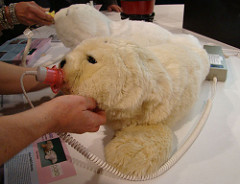Technology is becoming increasingly integrated into our daily lives. Whether through using a cell phone to stay connected with friends or writing on a tablet to take notes in class, technology has revolutionized the way we live. It is no wonder that technology has also made its way into the medical field. An invention that is a part of both the medical field and people’s daily lives is the therapeutic robot. Therapeutic robots, such as Paro and Keepon, are greatly beneficial to patients of all ages.
Paro is a robotic seal that has been used as an alternative for animal assisted therapy in Japan and Europe since 2003; there have been eight generations of Paro in total. As of 2009, the Federal Drug Administration (FDA) has classified Paro as a class 2 medical device. By 2010, around 40 were used in U.S. nursing homes. The robotic seal is equipped with touch, light, sound, temperature, and posture sensors, as well as some artificial intelligence. Patients touch and pet Paro as they do with therapy animals. Over time, Paro can “learn” its new name given by the user and develop a “personality” that suits the user. Paro remembers the situation in which it is petted and tends to repeat the behavior that led to the petting to the patient’s liking. Paro is beneficial to patients in the same ways therapy animals are, with some added bonuses. With Paro, patients don’t have to worry about the possibility of being bitten or scratched or not being able to use this form of therapy due to allergies. Also, unlike therapy animals, Paro does not require as much care and can be near the patients 24/7. Paro has proven to be useful particularly to the elderly with dementia or Alzheimer’s, relieving some of the patients’ symptoms such as distressed and disturbed behavior. The downside to Paro is that it is very costly; one unit costs around $5000 to $6000.
Image Source: Yamaguchi Haruyoshi
Keepon is a robot that was made to study children and their social interactions—especially how autistic children can interact with other people. A therapist controls Keepon using a computer connected to the robot through USB or Bluetooth. Keepon’s eyes are two cameras with a 120 degree field of view, and its nose contains a sensitive microphone. While a child is interacting with Keepon, a therapist can control the robot accordingly. Keepon catches the children’s attention through its simple design and basic movements such as nodding or turning and by imitating the children’s actions. It also encourages interaction, making the children want to touch the robot and its appealing soft and squishy body.
Though therapeutic robots come in different shapes and sizes, have different abilities and functions, and help people of different ages, they all ultimately contribute to one significant outcome: they help improve the quality of people’s lives.
Feature Image Source: Paro Baby Seal Bot by Inhabitat










